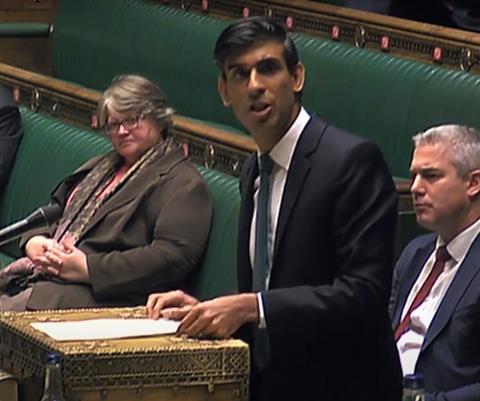Spending Review reveals cost of dealing with covid put at ┬Ż280bn ŌĆō and will rise further next year
The chancellor has unveiled a raft of measures intended to keep firms afloat in the coming years as the economy struggles to rebound from its largest contraction in more than three centuries thanks to the carnage caused by the covid-19 pandemic.
Stark economic forecasts published alongside the budget by the Office for Budget Responsibility revealed the economy will contract by 11.3% this year, the largest fall in output for more than 300 years, because of the pandemic.

Total spending on tackling the virus has so far hit ┬Ż280bn with a further ┬Ż55bn to be shelled out next year.
Borrowing this year is set to hit ┬Ż395bn this year, the highest recorded figure in the UKŌĆÖs peacetime history. It will hit 97.5% of GDP in 2025-26.
Rishi Sunak said the ŌĆ£cost of inaction [over covid] would have been far higherŌĆØ but warned the current level of borrowing was ŌĆ£clearly unsustainableŌĆØ.
And he said the number of people set to be thrown out of work by by the pandemic would jump to 2.6 million by the middle of next year. The latest figure is 1.62 million, a rise of 300,000 on last year.
Output is not expected to return to pre-crisis levels until the fourth quarter of 2022, with growth projected to be 5.5% next year and 6.6% the year after.
Sunak (pictured delivering his Spending Review statement to MPs this afternoon) said capital spending will total ┬Ż100bn next year, ┬Ż27bn more than in 2020 as he promised to continue funnelling government funds into the construction sector.
He announced a ┬Ż7.1bn National Home ║├╔½Ž╚╔·TV fund which will run over four years and would see up to 860,000 homes built.
It will be on top of the ┬Ż12.2bn affordable homes programme announced earlier this year and will include ┬Ż4.8bn of capital grant funding for land remediation, infrastructure investment and land assembly, as well as ┬Ż2.2bn of new loan finance to support housebuilders.
Spending rules for local authorities will be relaxed, allowing them to increase spending by up to 4.5%, while a new ┬Ż4.4bn ŌĆślevelling upŌĆÖ fund was announced which local areas will be able to use to bankroll local projects.
The fund will be managed by the Treasury, the Department of Transport and MHCLG with Sunak promising it will take ŌĆ£a new holistic place based approach to the needs of local areasŌĆØ.
Projects expected to be funded include new roads, upgrades to railway stations, improvements to high streets and town centres along with new libraries, museums and galleries.
But Sunak said that projects must be delivered within this parliament and be considered to ŌĆ£have a real impactŌĆ”command[ing] local supportŌĆØ including the backing of local MPs.
He also announced the launch of a new UK Infrastructure Bank which will work with the private sector to finance major new investment projects across the UK.
The bank, which has been created partially to replace the European Investment Bank which the UK will leave at the end of the Brexit transition period on 31 December this year, will be based in the north of England and will open next spring.
The idea was suggested by chair of the National Infrastructure Commission John Armitt, who said it could start with base funding of ┬Ż20bn.
Other measures include improvements to the way the apprenticeship system works for businesses and extensions to traineeships.
Sunak also earmarked an extra ┬Ż30m to help deliver the new building safety regime due to come into force in 2023, taking funding to at least ┬Ż70m ove the 2021/22 spending period. It will also include money for a new building safety regulator.




























No comments yet